Skelly Building
Introduction
Author-Uploaded Audio
Local historian Bill Worley elaborates on the significance of the oil industry in relation to Kansas City as a financial hub.
Text-to-speech Audio
One of the few buildings on the Plaza not controlled by the Nichols Company, the Skelly Building was built as the marketing and financial headquarters for Skelly Oil Company in 1938. Skelly Oil Company was founded in 1919 by William Grove Skelly (1878-1957) and based out of Tulsa, Oklahoma, the “Oil Capital of the World.” After taking interest in the Burbank Field on the Osage Reservation, Skelly started buying tracts of land and setting records at oil-lease auctions under the “Million Dollar Elm.” He quickly became one of the world's largest independent producers of oil and natural gas. The Osage tribe was paid directly from these leases and recognized Skelly’s influence on their wealth, later naming him an honorary member of the tribe as Wah-tah-in-kah, meaning “Sassy Chief.” William Skelly was also a philanthropist for the Tulsa community and became known as “Mr. Tulsa.” In 1977, Skelly Oil Company was bought out and merged to create Getty Oil.
Images
The Skelly Building on the Country Club Plaza opened in 1938 as the marketing headquarters for Skelly Oil Company
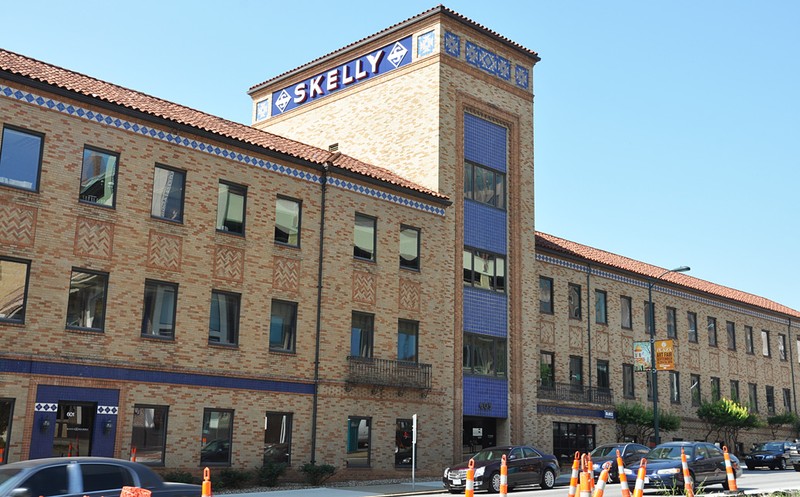
An early aerial photo of the Plaza shows the Skelly Building before additions were made on the east. Photo courtesy of Missouri Valley Special Collection, Kansas City Public Library
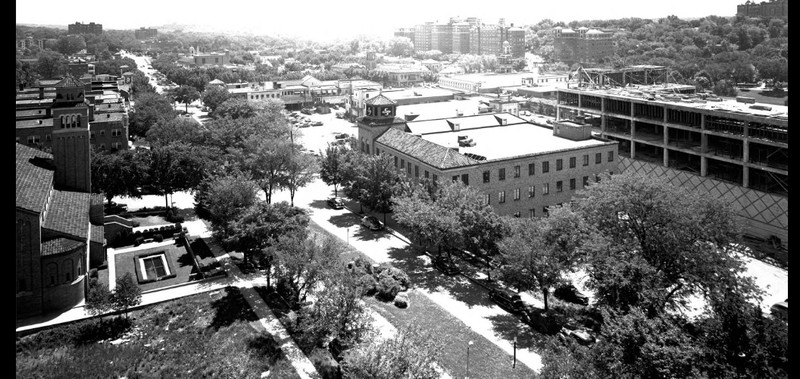
A Skelly Oil filling station at 2500 E 39th Street in Kansas City, Missouri (1935-1950). Photo courtesy of The Collections of The Henry Ford, Gift of John Margolies.
.jpg)
A Skelly Oil Company oil can - Skelly Quality Oils
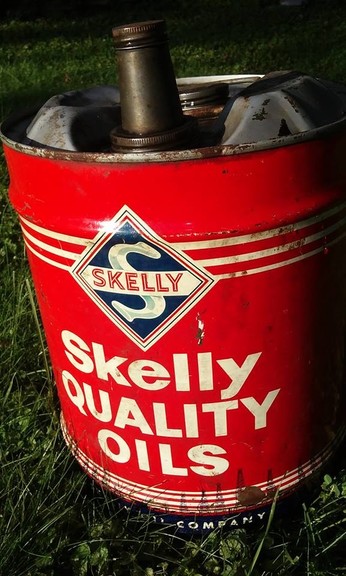
A Skelly Oil Company oil can - Fortified TAGOLENE Motor Oil
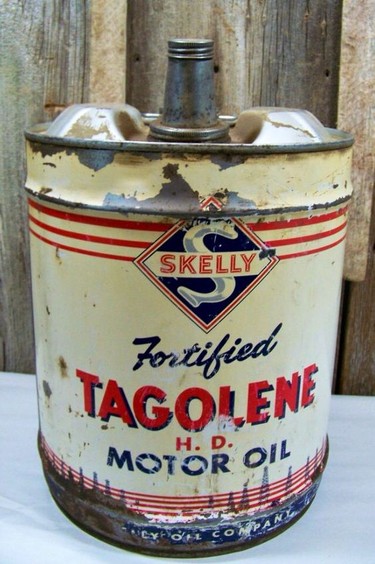
A 1940-1941 service station map provided by Skelly Oil Company, one of many forms of advertising by the company
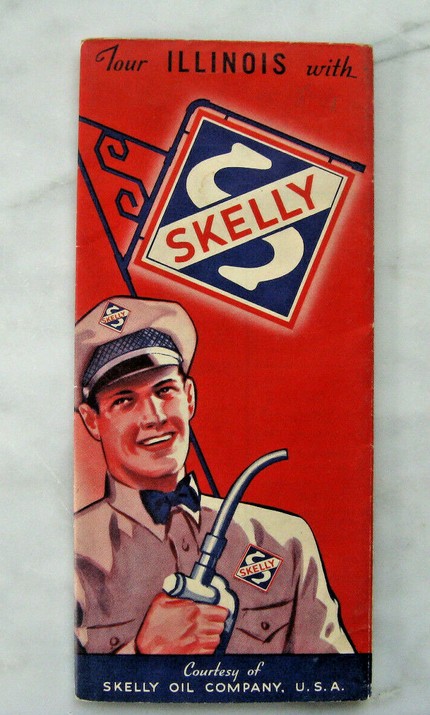
Photo of William Grove Skelly. Photo courtesy of Oklahoma Historical Society.
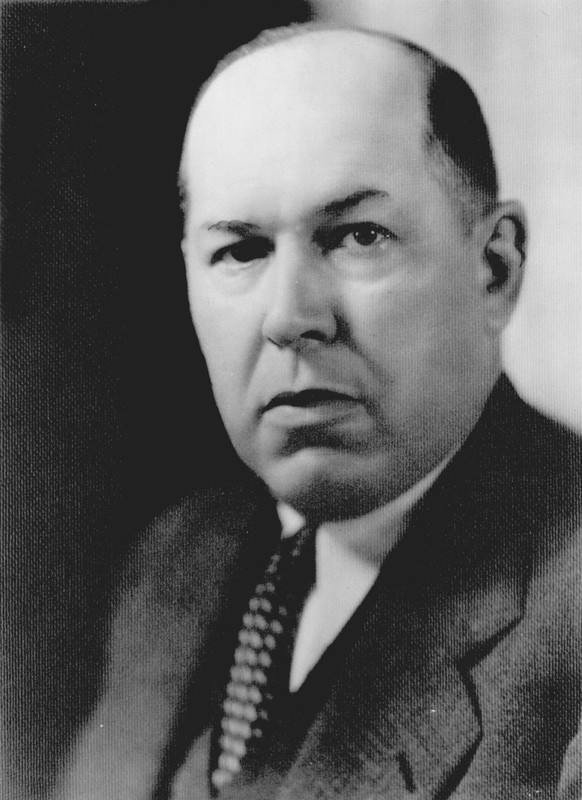
Auctioneer Colonel Walters (in stripes) under the Million Dollar Elm in Pawhuska, Oklahoma c. March 18, 1924
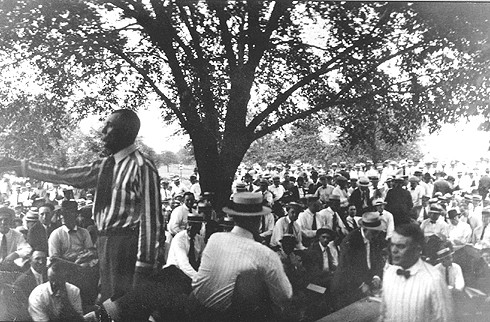
Backstory and Context
Text-to-speech Audio
The Skelly Building was constructed in 1938 as the marketing and financial headquarters for the Skelly Oil Company. Architect Edward Tanner designed this three-story commercial building using an Italianate style. With a boxy shape and flat facade, it features a low-pitched, hipped roof, tall symmetrical windows, and a central, campanile-style projection that displays the company logo. In addition, decorative brick patterns were laid within the facade between floors and tile detail under the eaves. Additions were made to the building in 1954 but continued to house Skelly’s offices until the company merged with Getty Oil in 1977. It remains a reminder of the importance of gas and oil to the early days of the autocentric shopping district, and currently provides retail, restaurant and business space.
William Grove “Bill” Skelly was an oil man and philanthropist born in Erie, Pennsylvania in 1878. His father instilled a strong work ethic and at a young age, William sold newspapers and cleared sidewalks in the winter. He finished public school at age 14 then studied for one year at Clark’s Business School. After school, he worked for his father hauling oil-well supplies in a horse drawn carriage which exposed him to the field. He worked for $2.50 per day as a tool dresser in the Venango Field in Pennsylvania and as an experienced oilman, was later sent to Oklahoma. In 1898, William enlisted in the Spanish-American War in the 16th Pennsylvania Volunteers for the Battle of Coamo in Puerto Rico. After the war, he moved to Gas City, Indiana and became a manager for Citizens Gas Company.
Skelly continued to learn more about the industry and new technologies. In the early 1900s, the production of Ford’s Model-T automobile and demands of World War I led the oil boom to expand, moving to the west and south. Barrels of oil produced in the United States in 1900 totaled 6,000, compared to 11,000,000 in 1914. With so much potential and knowledge, Skelly chose to go independent. First he landed in Texas, but in 1916 moved to Kansas when the El Dorado oil field opened. Soon after, he founded the Midland Refining Company and went into production in 1917. Midland quickly became one of the largest operators. This same year, Skelly formed the Mid-Continent Oil & Gas Association to ensure supplies were available for our allied forces in World War I. He partnered with owners of other major oil producers including Phillips Petroleum, Conoco Inc., and Kerr-McGee Oil Company, in addition to oilman Alf Landon, who would later become the Governor of Kansas (1933-1937) and the 1936 Republican Presidential candidate.
On October 2, 1919, William Skelly incorporated Skelly Oil Company and established its headquarters in Tulsa, Oklahoma, the “Oil Capital of the World.” He took interest in the Burbank Field on native Osage land in the early 1920s. By this time, the Osage had already established mineral rights as oil-lease auctions were being held for their land. Official auctioneer Colonel Elmer Ellsworth Walters held these auctions under a giant elm tree near the Osage Council House in Pawhuska, which became known as the “Million Dollar Elm.” On March 2, 1922, William Skelly set a new record when he partnered with Phillips Petroleum Company to purchase a quarter-section (160-acres), the first time a single tract sold for $1 million. The Osage was paid directly from the sales of successfully completed wells, in addition to interest, bonuses, and royalties. Between 1919 and 1928, more that $202 million was paid to the tribe. Unfortunately, the quick onset of wealth of the Osage brought on greed for the headrights to their land and led to a number of violent and suspicious deaths. On April 22, 1926, the Osage dedicated a 25-foot monument to Colonel Walters called the “Bond of Friendship” in honor of the success he had brought them.
By 1923, Skelly became one of largest independent producers of oil and natural gas. He had introduced a new system to the Burbank Field which preserved gas pressure, allowing it to flow naturally, as well as a system of pipelines to move oil from the field to the processing plants. He became President of the International Petroleum Exposition in 1925, founded Tulsa's Spartan School of Aeronautics in 1928 and was a major donor for the construction of Tulsa’s Municipal Airport in 1929 and Tulsa University's football stadium in 1930. At the end of the decade, Skelly Oil had sales representation in 11 states, owned 471 bulk and service stations, and had more than 4000 franchise dealers. It was also one of the first companies to partner with the interstate, creating a truck stop program and started offering a credit card.
As a public leader for civic, educational and charitable causes, Skelly became known as “Mr. Tulsa.” He was inducted into the Oklahoma Hall of Fame in 1939 for his charitable work in addition to the path he helped pave in the petroleum industry. The Osage tribe also recognized Skelly’s influence and made him an honorary member in 1949 with the name, Wah-tah-in-kah, meaning “Sassy Chief.” William Grove Skelly remained an industry giant until his death on April 11, 1957.
Sources
Anderson, Ken. Skelly, William Grove (1878-1957), Oklahoma Historical Society. Accessed January 25th 2022. https://www.okhistory.org/publications/enc/entry.php?entry=SK002.
Wells, Bruce A.. Million Dollar Elm, American Oil & Gas Historical Society. March 24th 2014. Accessed January 25th 2022. https://aoghs.org/petroleum-pioneers/million-dollar-elm/.
Wells, Bruce A.. Million Dollar Auctioneer, American Oil & Gas Historical Society. March 27th 2015. Accessed January 25th 2022. https://aoghs.org/petroleum-pioneers/million-dollar-auctioneer/.
Country Club Plaza Walking Guide, Historic Kansas City. Accessed January 25th 2022. https://www.historickansascity.org/wp-content/uploads/2017/09/90529_HKC_Plaza-NO-MARKS.pdf.
https://www.roadarch.com/gas/mo4.html
https://kchistory.org/image/country-club-plaza-41?solr_nav%5Bid%5D=7930fa8681c7596f02c7&solr_nav%5Bpage%5D=0&solr_nav%5Boffset%5D=7
https://www.thehenryford.org/collections-and-research/digital-collections/artifact/404137#slide=gs-327053
https://www.collectorsweekly.com/stories/205338-skelly-5-gallon-can
https://www.pinterest.com/pin/384424518172283582/
https://picclick.com/1940-1941-SKELLY-Service-Station-Map-of-Illinois-SKELLY-Oil-283923797237.html
https://www.okhistory.org/publications/enc/entry.php?entry=SK002
https://aoghs.org/petroleum-pioneers/million-dollar-elm/
